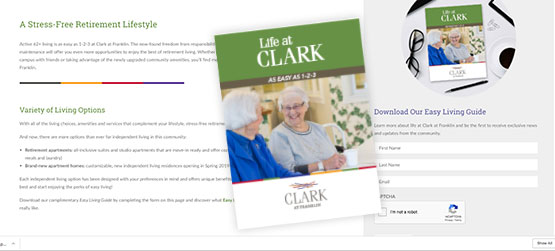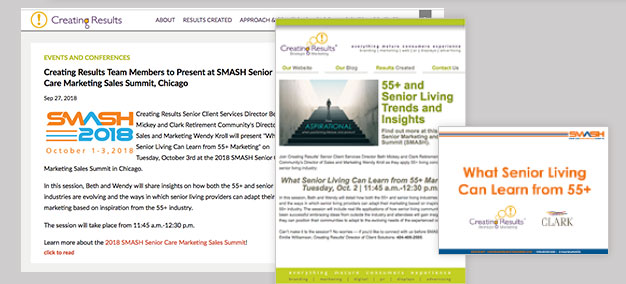It’s hard not to look forward to this time of year. But while many people anticipate fall festivities and the aroma of pumpkin spice, I usually find myself counting down the days to the fall conference season. I had the opportunity to attend the Senior Care Marketing Sales Summit (SMASH) for the first time from Oct. 1 through Oct. 3, and I’m already excited for next year’s conference.
The energy at the conference was remarkable and I learned a lot from the industry experts who were speaking my favorite languages: sales and marketing. That’s why I’m excited to share with you my four biggest takeaways from SMASH.
1. Create Killer Content That Converts
I’ve always seen content as a happy medium between the messages that businesses want to deliver and the ones that consumers want to receive. I had the opportunity to sit in on a session led by Zontee Hou, President of Media Volery and a content marketing expert, who re-iterated this point in her presentation.
The insights she offered really put into perspective the mistakes that many companies make when they produce content. Mostly, they create content that doesn’t offer value to the customer or take into consideration not only their needs, but also their motivations. In addition, many companies aren’t creating content with a plan or an end goal in mind. Thankfully, Hou let us on in her own thought process for creating content that converts with customers:
- Plan your content: Determine the theme of your content and the goal(s) you want the content to achieve. For example, you may decide to create a senior living guide with the goal of bringing in new leads.
- Offer value: Your content should address the needs and motivations of the customer and offer them information they won’t find elsewhere.
- Optimize your content based on the channel: There’s no one size fits all solution for content distribution. What works on one channel, may be ineffective on another. Study your audience’s behavior on each channel and distribute your content accordingly.
- Promote your content: One point the Creating Results team would like to add is that you can make a goal, create valuable content and optimize it for different channels, but if you don’t promote it, it’s not going to be successful
2. Don’t Let Your Budget Hold Your Content Back
Sonya Bradley, Chief Marketing Officer at Visit Sacramento, said something that has stuck with me in the days since the conference: “Relevance is a form of respect, and that goes for content, too.”
What I took away from this SMASH session is that creating content that builds a “trail of trust” with your prospects doesn’t have to break the bank, nor does it have to be an overly complicated process. Marketers can benefit from several aspects of Bradley’s approach to content. I know I’ll be revisiting many of the insights tips she offered, including:
- Develop a foundation: Determining your organization’s goals and objectives, auditing owned channels (your blog should be your content home base), evaluating your audience and identifying internal subject matter experts are the first steps in content planning.
- Build content: Repurpose your content to be shared multiple times across multiple channels.
- Build trust: Your customers may not be ready to buy just yet, but you can become a resource that they refer back to if you create the right content.
- Expand your arsenal: Find the applications that will help you create content more efficiently. In Bradley’s case, Trello is an important tool for her team. It’s a free cloud-based content calendar where all aspects of her team’s content development process are managed.
In addition to the steps outlined above, monitor your audience for additional inspiration. One of the best things about social media is that it can be a goldmine for content creation. Did someone leave a comment asking a question about your product on Facebook? Answer that question in a new piece of content. You also shouldn’t be afraid to try out new content ideas, such as creating videos. Just be sure the content adds value to your prospects and is aligned with your brand.
3. Use Data to Improve Sales Performance and Increase Move Ins
“Getting leads is easy. Converting them is hard.”
If there’s one thing every salesperson in the world can relate to, it’s the above quote from Alexandra Fisher, Co-founder and Chief Creative Officer at Sherpa. In her SMASH presentation with Jason Rock, Vice President of Sales and Marketing at Allegro Senior Living, she stressed the importance building trust with prospects, especially considering that we’re selling them a change from their current lifestyle.
Fisher and Rock introduced the session’s attendees to micrometrics – the data needed to build trust and drive relevant movement with a prospect:
- Planning: a critical step for meeting with a prospect
- Duration: the amount of time that you’re in the selling zone
- Outcome: the result of the engagement
- Discovery: the information you learned about the prospect
- Creative follow up: personalized initiatives based on information gathered from the discovery process
Per Fisher, it’s important to keep the flow of the sales process in mind. Start with connection, then untangle and discover the prospects needs and finally, advance and go for the sale when the time is appropriate. Remember, you have to open people before you can close them.
4. Steps for Digital Transformation
Having a digital marketing strategy is a must in today’s in today’s marketing environment. Rochelle Valsaint, Brand and Communications Manager at Lenbrook Senior Living, shared her community’s initial hesitation about investing in digital. But now, it’s become an integral part of their marketing strategy. She offered 7 steps that she took to gain buy-in to embrace digital:
- Assess the organization’s internal perception of marketing.
- Assess if the importance of the marketing and sales departments in the organization is balanced; one shouldn’t take priority over the other — they should work together.
- Get buy-in and support for digital changes from influencers in the immediate team, sales, senior leadership and the board of directors.
- Research and define budget parameters.
- Decide on division of labor. Determine which tasks you can do internally and which ones you may need to leverage an agency partner for.
- Implement processes, tools and systems needed for all marketing channels.
- Keep an eye on your results and adjust where necessary.
After taking these steps into consideration, I realized that they can be applied not just for digital, but for introducing any new strategies to your integrated marketing plan. The keys are to determine how a new strategy will help your company and to get buy-in from the necessary stakeholders.
I wasn’t ready for the conference to end when it did, but I was excited to get back and share everything I learned at my first ever SMASH conferences with you. I’m fortunate to have gotten the opportunity to learn from industry experts, as well as present on behalf of Creating Results, and I look forward to attending in the future!
Get More Insights with eNews
Sign up for eNews to keep up with the latest mature marketing insights, as well as the latest trends in the 55+ and senior living industries.




